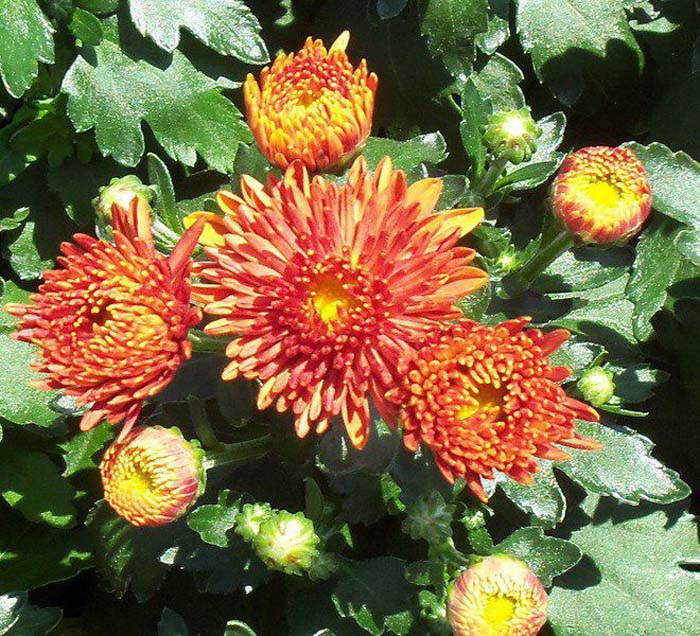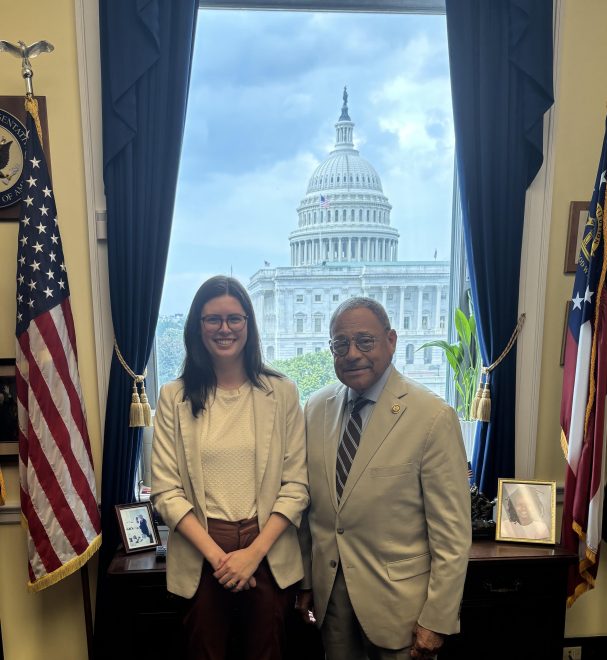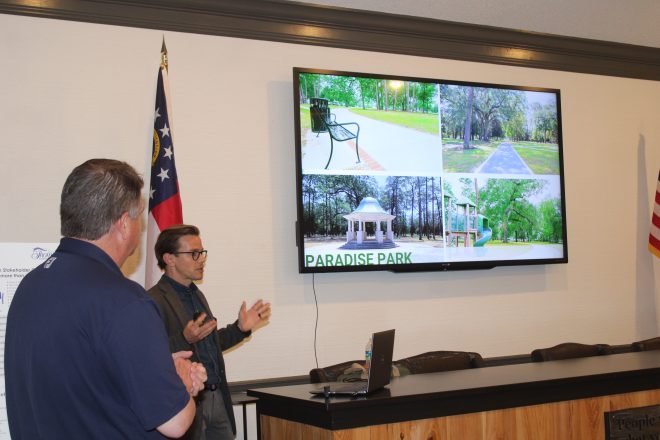Yarden Notes
Published 8:00 am Saturday, September 7, 2019

- Shown are chrysanthemums.
Yarden” (Yard + Garden) Notes for September 2019
Sponsored by Thomasville Garden Club Inc.
Trending
HURRICANE DORIAN
Our hearts and prayers go out to all those affected by Hurricane Dorian, especially the poor battered Bahamas. We are very grateful that the southeast coast of Florida and Georgia has been spared the brunt of the storm. We hope and pray that the rest of the Eastern Seaboard fares well, too.
I apologize for this “spoiler:” I have to remind everyone, including myself, that hurricane season usually peaks between mid-August and late October and does not end until November 30.
RECORD SUMMER 2019
In July’s column, I reported NOAA’s announcement that June 2019 was the hottest June on the planet, dating back to 1880, when such records began to be kept. News was released last month (August) that July 2019 was the hottest month in all recorded history. (Sources: Earth/Sky, eos.org, Big Think.) This record was true the world over; heat “soared” even in such unusual places as Alaska, the Arctic, Greenland and Siberia. Data was taken from readings of numerous weather balloons, satellites and other temperature-measuring sites. Interestingly, July’s record was achieved without the influence of El Niño, which adds heat to oceans and the atmosphere. The previous hottest-month ever recorded was July 2016.
SEPTEMBER WEATHER
Trending
Temperatures begin to moderate this month, especially at night. Also, September usually brings a decrease in rainfall. Weatherspark.com lists our “warm season” ending on September 23, which is the day after this year’s autumn equinox. Homefacts.com reports Thomasville’s average September temperature as 76.6 degrees. U.S.climatedata.com states our average September high and low temperatures as 87 degrees and 67 degrees and our average precipitation as 4.53 inches (down more than an inch from August’s average).
SPECIAL DATES
On Saturday, Sept. 7 (today), if everything goes well, India’s space mission vehicle, Chandrayaan-2, will soft-land on the on the moon’s south pole. Instruments on its rover, Pragyaan, will study the topography and chemical composition of the moon and map the presence of lunar water. Chandrayaan-1, which was launched in 2008, confirmed that there was lunar water and that ice was present in craters in its southern hemisphere. If Chandrayaan-2 is successful, it will be the fourth country to complete a lunar soft landing. (The U.S., China and the Soviet Union are the first three.)
Friday the 13th — Do you have friggatriskaidekaphobia? That is an irrational fear of Friday the 13th. If you do, take heed: Exactly 13 weeks from this month’s Friday the 13th, a second Friday the 13th will occur in December.
Saturday, Sept. 22 — This is the date of the September equinox, marking the beginning of autumn in the Northern Hemisphere. Here in Thomasville, the equinox will occur on Monday, Sept. 23, at 3:50 a.m. Eastern Daylight Time (latitude determines the precise local time). Over the course of a year, the angle of tilt never varies — it is approximately 23.4 degrees — and our distance from the sun does not change very much but the orientation of the tilt does, either toward or away from the sun. On the equinoxes, Earth is tilted on its axis as usual but because of its path around the sun, the tilt is perpendicular to the Sun’s rays. On this day, the sun shines directly upon the Equator and the length of day and night is very nearly (but not exactly) equal. On subsequent days, we will experience increasingly later dawns and earlier sunsets. The sun’s journey across the sky each day will shift toward the south. In the Southern Hemisphere, spring is beginning.
Wednesday, Sept. 26 — John Chapman was born on Sept. 26, 1774, and his birthday is recognized annually as ‘Johnny Appleseed Day.’ He spent more than 50 years traveling and introducing apple trees to about 100,000 square miles of Pennsylvania, Ohio, northern West Virginia, Indiana, Illinois and Ontario, Canada. He was an early leader in conservation and accomplished a rare feat: he became an American legend while still alive. I just learned that it is possible to visit one of John Chapman’s trees. In Nova, Ohio, is a 177-year old tree that is the last-known apple tree alive to have been planted by Johnny Appleseed. It grows tart green apples that are used for applesauce, baking, and making cider. Eat an apple in his honor today — and keep the doctor away for another day.
ASTEROID STRIKE – HOAX
There have been a number of stories about asteroid 2006 QV89. Hype in the media and online has it that the space rock will strike the Earth on Sept. 9, when it is due to pass closest to our planet. Many asteroids temporarily appear on a “risk list” due to their uncertain orbits. Asteroid 2006 QV89 is on one of those lists but it is not on a “priority list.” According to the European Space Agency (ESA), asteroid 2006 QV89 will show a maximum magnitude (brightness) of +21.9. However, that is still so faint that it will not be visible with most telescopes, except those huge, observatory types. Also, deep images of an area in the sky where the space rock should appear if it were on a collision-course with Earth this month show no sign of it. Asteroid 2006 QV89 is classified by astronomers as no hazard. It is not expected to hit Earth.
WEST NILE VIRUS – NOT A HOAX
On August 16, I read in the Times-Enterprise that 2019’s first human case of West Nile virus had been confirmed in Camilla (Mitchell County). You probably read that, also. Camilla is a little more than 30 miles away; that is very close to home.
In a typical year, Georgia has six to 10 cases of WNV. August 15 to September 15 is Georgia’s peak season for this disease because that is when Southern mosquitoes are most active. Mosquitoes’ prime feeding times are at dawn and dusk.
Most people infected with WNV do not show symptoms. However, about 20 percent of those infected will experience body and joint aches, rashes, vomiting and diarrhea, according to the CDC. Of those, only about one percent will develop acute symptoms. Older Georgians are much more likely to become seriously ill from West Nile virus. This year’s first victim is such a person: an elderly male with health problems.
Be certain that your property is not a breeding ground for mosquitoes. Eliminate standing water everywhere. There are very effective EPA-approved granules and dunks for drainage systems and low-lying and boggy areas and where fish and other aquatic predators do not live. There are EPA-approved products for ponds and the like, also. These products can be found at garden centers and feed and seed stores.
When outside, wear light-colored clothing and long sleeves and pants whenever possible. Without fail, use EPA-approved repellents, such as DEET.
Our best protection against WNV and any other mosquito-borne disease is to avoid being bitten. Stay safe.
TOXIC ALGAE – NOT A HOAX, EITHER
UGA’s College of Agricultural and Environmental Sciences reports that several dogs have lost their lives after swimming in lakes and ponds containing a blue-green algae species that is a liver toxin. Algae can grow in such bodies of water when conditions are as unusually hot and dry as they have been lately in Georgia. Algae can look like green, bluish green or reddish brown blobs of paint floating on the water’s surface. The report stated that humans and animals should not swim in bodies of water that evidence an unusual color, have scum on them, or have poor visibility less than 12 inches below the surface. And, certainly, humans and animals — pets or farm animals — should not drink from them!
IN FLOWER
Perennials are beginning to emerge. Look for chrysanthemums — an autumn favorite, American beautyberry, autumn clematis, goldenrod, Mexican sage, pineapple sage, sedum and red spider lilies this month. After a thorough rain, I enjoy finding clusters of rain lilies (Zephranthes) bursting from the ground with their white, yellow or pink flowers.
TO DO
I cannot help thinking of my dear friend, Betty Jinright, who passed away in May. She always urged me to remind everyone that the dreadfully invasive skunk vine is blooming now and NOW is the best time to attack it and keep it from spreading. Pull it off plants and pull runners off the ground at every opportunity and be sure to destroy its roots. Do not dispose of skunk vine on brush piles because its seeds can readily germinate there and its stem fragments root voraciously. We need to put the “pullings” and any roots we get into tightly closed plastic garbage bags to keep them from coming into contact with soil and spreading.
You can plant beets, bok choy, cabbage, carrots, chard, collards, garlic, kale, kohlrabi, leeks, mustard greens, parsnips, radishes and turnips this month.
If you plant onion seeds in September, you can enjoy little onions (scallions) in just a few weeks. They will grow larger through the winter and you can harvest them at whatever size you want. By late spring, they will have grown into nice plump bulbs.
Plant parsley — but consider planting more than you think you will need because its lacy leaves add a great look to its location and it will grow through the winter. (However, you will want to replace overwintered parsley in the spring because it will not flourish a second year. Even if you harvest some leaves, they will not be as flavorful or may even be a bit bitter and then it will begin to flower, set seed and die.)
Plant Johnny Jump-Ups (violas) for three good reasons: Their color; they make a pretty and tasty addition to salads or garnishes for other dishes; and they will return every year without a bit work on your part.
Plant ornamental cabbage and kale, calendulas, dusty miller, marigolds, pansies, petunias and snapdragons.
Divide perennials. If possible, do so before rain is predicted. Fall’s cooler temperatures and a gentle rainfall will help the plants recover from any dividing and transplanting trauma they might experience.
And, of course, plant or purchase pots of chrysanthemums. Their colors are wonderful and numerous (except blue) and they are long-lasting — especially if you keep deadheading regularly. They have a long “vase life,” too. Do not deadhead these. But do change the water daily. Trimming their stems frequently also helps keep them fresh.
SEPTEMBER QUOTE
“It’s September! It’s the fullness and the ripeness of the year” — from “It’s September”
by Edgar Allen Guest, English-born American poet, 1881-1959.
Pat Pankey writes this column for Thomasville Garden Club Inc. as a service to the community. Thomasville Garden Club, Inc. welcomes new members. If you are interested, please contact Membership Chair Julie Feinberg (229) 224-5771 or any current member. The Garden Center has a library of books about gardening that are available not only to garden club members but also to the general public. To access the library or to visit the Garden Center, please contact Caroline Flowers (229) 200-9197 or any current member. You may contact Linda and Joe Tarver (229) 403-1187 if you are interested in renting the Garden Center for an event. The Garden Center is always open to the public on the Wednesday before the first Friday of every month, September through May. Please visit our website at www.thomasvillegardenclub.org and find us on Facebook.





